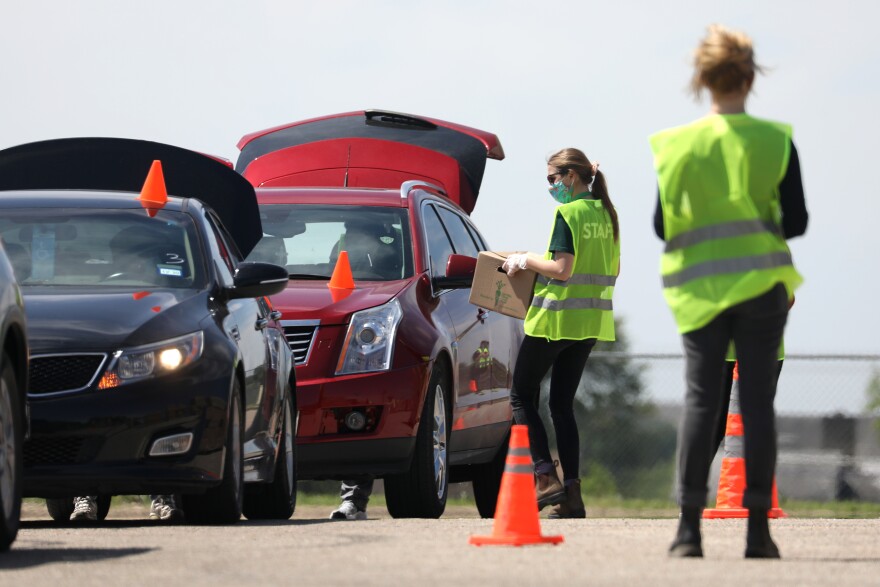Food insecurity has spiked during the pandemic, and local organizations don’t expect it to decline any time soon.
More people are returning to their regular activities after getting vaccinated and after the Centers for Disease Control and Prevention loosened guidelines last week. But many Central Texans are still grappling with the financial impacts of the pandemic.
Derrick Chubbs, president and CEO of the Central Texas Food Bank, said the food bank has seen a slight decline in clients in recent months but demand is still considerably higher than it was before the pandemic. He doesn’t anticipate it going down soon.
“So many of our clients were impacted so severely during the pandemic, and it takes quite a while for them to recover,” Chubbs said.
The food bank provides food to people in need in 21 Central Texas counties, including Travis, Williamson and Hays. Between January and March, the food bank was serving about 337,000 people per month. Chubbs said that’s 38% more people than it was serving during the same period last year and 41% higher than in the same period in 2019.
During the pandemic, the food bank began hosting eight to 10 mass drive-thru distributions each month, in addition to its regular mobile food pantries, to help meet needs. It has no plans to end those in the near future, Chubbs said. The events still see more than a thousand attendees.
“We’re going to continue those until we see the demand decline to such a point that we can cover it in other ways,” he said.
Summer is also approaching, which is typically a peak season for the food bank. Kids are out of school, so they don’t have access to free and reduced lunch programs, and it’s hot, so utility costs are often higher for folks.
“Our clients' expenses go up,” Chubbs said. “And naturally, if their expenses go up, they depend on us in many cases to help fill the gap.”
Meals on Wheels Central Texas has also seen needs increase significantly during the pandemic. The organization provides meals to homebound older adults and people with disabilities. Theresa Medlin Crawford, vice president for volunteer services and distribution, said the organization gained about 1,500 new clients during the pandemic. It was already serving about 3,000.
“It has been a dramatic increase,” Crawford said. “Texas ranks as one of the worst states for senior hunger, so it makes sense why our numbers have increased like this.”
Crawford said the organization doesn’t expect those 1,500 people to stop utilizing the program after the pandemic. Less than 100 of those individuals are expected to roll off the program.
“The rest will have to stay on because they will still need additional food,” she said.
Before the pandemic, Meals on Wheels delivered hot meals to clients daily. But when the pandemic began, the organization shifted operations to help prevent the spread of disease. Volunteers began distributing frozen meals and shelf stable food items to clients every other week.
Now that more people have gotten vaccinated against COVID-19, Meals on Wheels is planning to return to its daily distributions. The organization’s goal is to resume daily hot meal deliveries Aug. 23.
Crawford said many volunteers are excited to get back to the daily deliveries so they can socialize with clients again. In addition to delivering meals, volunteers also chat with clients, checking in with them to make sure they’re OK or to see if they need any home repairs.
“We're delivering food and we're providing nutrition, but [also] the human connection that comes with that,” she said. “That day-to-day visit, oftentimes the volunteers might be the only person that homebound person even sees or gets to visit with.”
But returning to daily deliveries with 1,500 more clients than usual isn’t exactly easy. Crawford said the organization needs more volunteers.
“Right now we have a deficit of over 300 open routes,” Crawford said. “We have need all over Austin, but some of our largest areas of need right now are the central and east side of Austin, east of 35, as well as the north and northwest areas.”
Crawford said volunteering only takes an hour a week during lunch time. People can learn more about how to volunteer with Meals on Wheels here.
The Central Texas Food Bank is also looking for more volunteers as summer approaches, particularly in the more rural areas it serves, such as in Hays, Bell, Llano and San Saba counties. People can sign up to volunteer with the CTFB or make a monetary donation at CentralTexasFoodBank.org. The website also lists locations where people can find food in their area.
The next mass drive-thru distributions are Thursday at the Travis County Expo Center and Saturday at the Austin Community College campus at 1200 Kohlers Crossing in Kyle. They run from 9 a.m. to noon.
Got a tip? Email Marisa Charpentier at mcharpentier@kut.org. Follow her on Twitter @marisacharp.
If you found the reporting above valuable, please consider making a donation to support it. Your gift pays for everything you find on KUT.org. Thanks for donating today.
Copyright 2021 KUT 90.5. To see more, visit KUT 90.5. 9(MDAwMTM1NDgzMDEyMzg2MDcwMzJjODJiYQ004))

